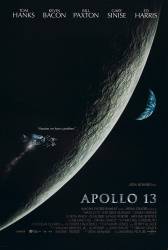Factual error: The Apollo 13-Saturn V vehicle was rolled out to the launch pad on 16 Dec 1969, not two days before launch, as portrayed.
Factual error: When astronauts are wearing their spacesuits before launch, we can see NASA's "snake logo" introduced in 1975, when the plot is happening in 1970. (00:28:29)
Factual error: During the final voiceover, Jim Lovell says "Fred Haise was going back to the moon on Apollo 18, but his mission never flew." In reality, it was Apollo 19, not 18, that Haise was tentatively chosen to command.
Factual error: The remaining smoke plume after the Saturn V liftoff is about 80 miles too low. It's apparent that an aircraft flew over the space center to leave a feeble 'movie' plume. Also, when the Apollo 13 crew blasts out of Earth orbit, the ship is pointed straight at the Moon, meaning that once they travelled the 240,000 miles to the Moon's orbit path, the Moon would be several thousand miles to their left.
Factual error: Hanks as Lovell drives a red corvette. The real Lovell has said in interviews he drove a blue corvette.
Factual error: As Lovell explains the Apollo 1 fire to his son (in 1967), a large RC model aircraft can be seen over the child's shoulder. The N-Number (tail number) for FAA registration is N1976M. The particular aircraft represented on screen is a Cessna 182P - which according to FAA records - wasn't built until 1976. (00:14:50)
Factual error: At the end of the movie, when the astronauts debark from the helicopter and are surrounded by the crew of the U.S.S. Iwo Jima, there are a number of junior enlisted men wearing combination caps. (The type worn by Chief Petty Officers and commissioned officers.) That they are junior enlisted men is obvious by the rank insignia on their left sleeves and by the silver USN and Eagle emblem on their caps. (Chief's caps have a large gold and silver anchor insignia, and officer's caps have a large gold officer's crest.) The U.S. Navy did, for a few years, replace the junior enlisted men's traditional white hat with the combination cap, but the change was not announced until 1972, two years after the Apollo 13 mission, and the Navy reverted to white hats in 1983, twelve years before the movie was made.
Factual error: On July 20, 1969, the moon phase was waxing crescent. In the movie, on the eve of the moon landing, the moon is shown in waxing gibbous phase when Lovell (Hanks) covers the moon with his thumb. (00:06:02)






Answer: From what I have read, according to the real astronauts, it was not as cold in the capsule as was depicted in the film. The movie exaggerated that for dramatic effect.
raywest ★